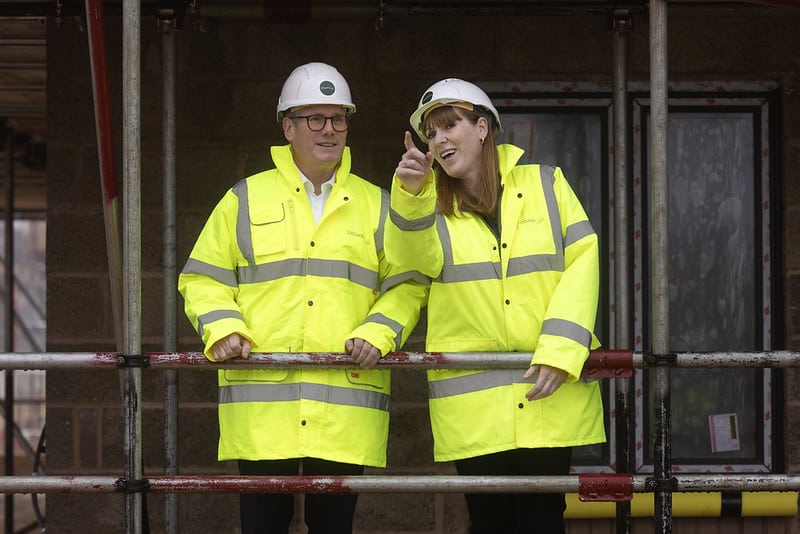Britain’s spiralling housing crisis is a further grim indicator of capitalism’s inability to provide for the most basic needs of growing numbers of the working class. In the last year, homelessness increased by 14%. The housing charity Shelter calculated in December 2024 that more than 350,000 people in England – including 161,500 children – were homeless, the equivalent of one in every 160 people. That figure is driven by soaring private sector rents, rising evictions and the dearth of social housing. Meanwhile, millions of people are living in cramped, mouldy and unaffordable accommodation that fails decent homes standards. The Labour government’s extravagant promises of 1.5 million new homes over its five-year term – which it cannot, in any case, deliver – offer no respite from this misery, poverty and insecurity.
Not all housing is created equal
In her October 2024 budget, Labour chancellor Rachel Reeves announced investment of £5bn over 2025 and 2026 to deliver on government housing plans. This included adding £500m to the so-called Affordable Homes Programme, promising an additional 5,000 ‘affordable’ homes. Reeves also committed £3bn of additional support for small and medium-sized enterprises and the build-to-rent sector to support the private housing market. Local authorities have been set vastly expanded targets to increase the provision of homes of all tenures in the coming period. But the devil is, as ever, in the detail.
The use of the term ‘affordable’ is Orwellian Newspeak. Set at 80% of market rent, such homes have been shown to be completely unaffordable for the majority of the working class. Most are Shared Ownership homes, a step towards eventual home ownership aimed squarely at those with an income of up to £80,000pa. Housing charities are clear: only the provision of at least 90,000 homes a year at a social rent can begin to address the country’s housing needs. In 2023 national average ‘affordable’ rent was £700 a month, compared to £450 social rent. The mandatory housing targets handed to local authorities do not specify what proportion needs to be for social rent. Cash-strapped local councils are increasingly scrapping provision of such housing. In 2024 three Labour-run local authorities in London – where the housing crisis is most extreme – wrote off £240m of planned social rent homes. Most councils no longer deliver any kind of affordable housing themselves, relying instead on the paltry amount generated by Section 106 agreements requiring private developers to provide a modicum of ‘affordable’ housing in their projects. The outcome of such a policy is aptly demonstrated by a development of luxury flats in the Labour-run borough of Southwark in southeast London, where Berkeley Homes have just reduced their ‘affordable housing’ offering from 35% to just 12% in their proposed redevelopment of Peckham town centre; elsewhere in the borough, a private developer has asked to sell flats destined for ‘affordable’ housing on the open market after housing associations said they could not afford to buy them. This is happening across the country. Across Britain, fewer than 5,000 homes for social rent were completed in 2023/2024, while 1.3 million households wait on local authority housing lists. London saw a record downturn in building any kind of ‘affordable’ housing in 2023, with 88% fewer units started in the year to March 2024, a decline from 26,386 to 3,156.
The market cannot solve the crisis
Labour may talk of ‘kickstarting the biggest growth in affordable housing in a generation’, but in reality its focus is on attracting investment into mass building of homes for private sale. In a sinister reminder of the ‘bonfire of red tape’ of the 2015 Conservative government, Labour leader Keir Starmer has promised to ‘bulldoze’ through red tape in the drive for ‘growth’. To that end, Labour will ride roughshod over local planning objections and environmental protections, with councils mandated to offer up swathes of green belt land to developers and housebuilders required only to pay into a central ‘environmental protection fund’. As an additional incentive, the government has withdrawn an original requirement that housing built on the green belt must include 50% ‘affordable’ homes.
Labour hopes to reverse the collapse in home ownership with bribes to better-off sections of the working class. 53% of people in Britain now own their own homes, down from 63% in 2018, and just 35% of those aged 25 to 34 are now homeowners. Yet despite its raft of sweeteners to the private sector, Labour’s plans look doomed to fail. Most homes in Britain are built by a handful of large housebuilders, private companies generating huge profits for their investors. Their interest lies not in resolving the housing crisis but in protecting their 20% profit margins. In order to keep house prices high, they will bank land which has planning permission and watch its value increase while reducing the number of homes coming onto the market. Despite government complaints about ‘planning bureaucracy’ preventing housebuilding, the reality is that there are around a million sites across Britain with planning permission that remains unused. All the major housebuilders say they expect to build the fewest new homes in a decade in the coming year – around 50,000 – as ‘declining sales mean housebuilders have pulled back from buying land and opening new sites, reducing their output and trying to avoid having to cut the price of their homes’ (Financial Times, 24 December 2024). This is the logic of capitalism.
Housing is a human right
What Labour has completely failed to address are the real drivers of homelessness. In the private rented sector, now accounting for a fifth of all households, rents are rising at their fastest rate in decades – up 9.1% across Britain in the 12 months up to November 2024 and 11.6% in London. Just 5% of homes in the private rented sector are now affordable to those in receipt of housing benefit. Local Housing Allowance has completely failed to keep pace with rising rents. In May 2024 the Joseph Rowntree Foundation reported that 80% of those reliant on housing benefits were going without essentials such as food and heating. The Resolution Foundation says Britain’s housing crisis is a major driver of child poverty.
Last year, 57,340 households in England needed council support after being threatened with homelessness following the end of a private rented tenancy – a 4.6% rise on the previous year. Across England a record 123,100 households, including 159,380 children, are now living in cramped, insecure, makeshift temporary accommodation. In Scotland, where a total of 16,330 households were in temporary accommodation, the government was forced to declare a housing emergency. Local authorities say housing these families is decimating their budgets, at a cost of a record £1bn in the year to August 2024. In London – where councils spend £4m a day on temporary accommodation – homelessness was up 68% last year, accounting for one in every 20 children in the capital.
The Labour government, like the Conservatives before it, is neither capable of nor interested in resolving this crisis. The search for illusory ‘growth’ is a desperate attempt to shore up capitalist profits, while trampling on the interests of the working class. There must be resistance, a new movement that demands decent, safe and publicly funded homes for all who need them, not as crumbs for a few from the tables of the profiteers, but as a basic right.
Cat Wiener




